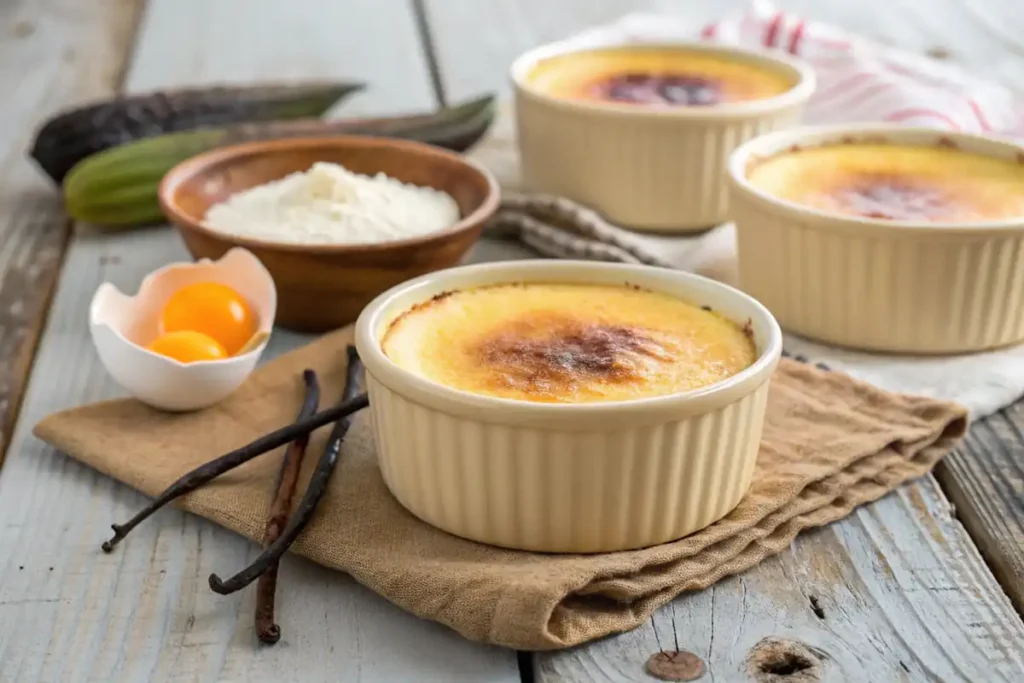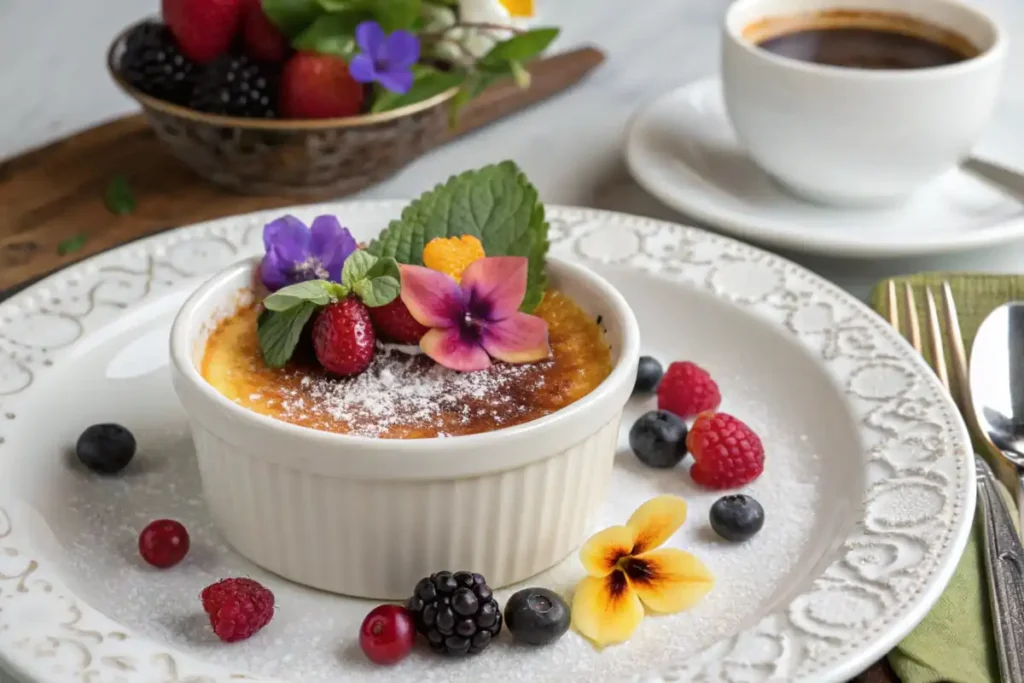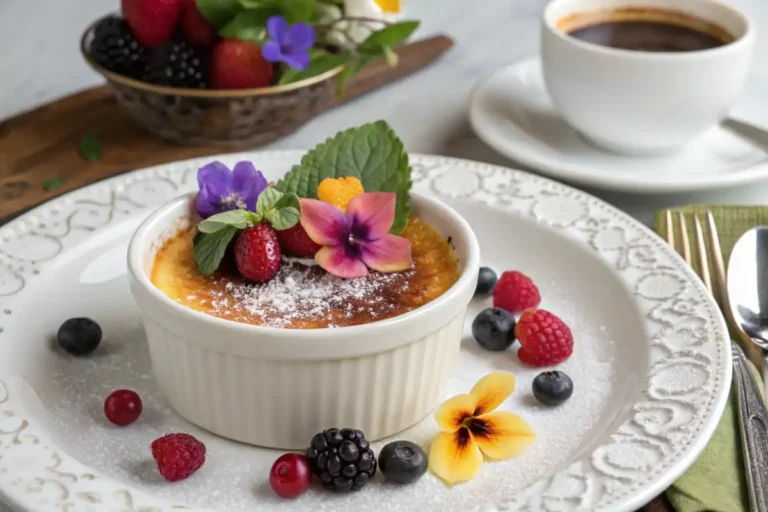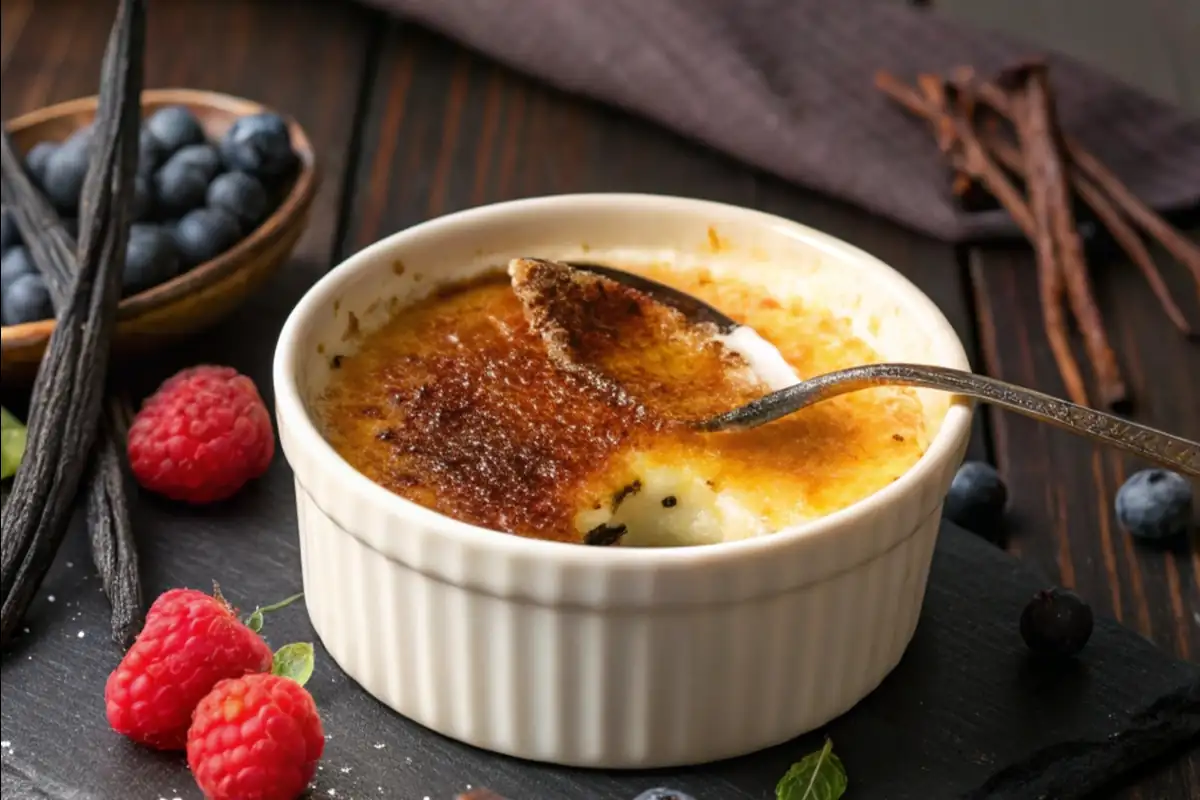1. Unveiling the Magic of Crème Brûlée
Crème brûlée isn’t merely a dessert; it’s a true work of culinary art. To truly appreciate what is the secret to crème brûlée?, one must explore its elegant simplicity. Renowned as a staple on gourmet menus for decades, its luscious custard base and glass-like caramelized sugar top offer a delightful contrast of textures that few desserts can match.
1.1 What Makes Crème Brûlée Unique?
The magic of crème brûlée lies in its perfect blend of two contrasting textures, brought together effortlessly:
- The Custard Base: Silky, creamy, and rich, the custard is the heart of the dessert. Its smooth texture melts in your mouth, offering a velvety experience.
- The Sugar Topping: A thin layer of caramelized sugar creates a brittle crust that shatters beautifully under a spoon, adding a satisfying crunch.
The combination of contrasting textures is what truly sets crème brûlée apart. The contrast elevates the dessert, making each bite a delightful combination of creamy and crispy.
1.2 Why Is It Challenging to Master?
Despite its short list of ingredients, crème brûlée can be tricky. Precision is critical. Minor mistakes, such as overheating the cream or overbaking the custard, can ruin the dessert entirely. Achieving that perfect sugar crust without burning it is another skill that takes practice.
But don’t worry—this guide will simplify the process and unveil all the secrets you need to master this iconic dessert. By the end, you’ll know how to make a crème brûlée that rivals even the best restaurants.
2. The Foundations of Crème Brûlée
Before diving into advanced techniques and flavor innovations, it’s essential to understand the basics of crème brûlée. Grasping what is the secret to crème brûlée? starts with these fundamentals, which lay the groundwork for mastering the dish.
2.1 Understanding the Core Ingredients
The magic of crème brûlée lies in its simplicity. With only a handful of ingredients, each one plays a crucial role in creating the perfect dessert.
- Heavy Cream
Heavy cream forms the base of the custard, giving it its luxurious texture. Full-fat cream is essential for achieving that signature richness. Using substitutes like low-fat milk can compromise the custard’s consistency. - Egg Yolks
The yolks act as the thickening agent, providing structure and silkiness. Be sure to separate the eggs carefully, as even a tiny amount of egg white can alter the texture. - Sugar
Granulated sugar is used in two stages:- In the custard, to add sweetness.
- On top, to create the caramelized crust.
- Vanilla
Authentic crème brûlée often uses fresh vanilla beans for their aromatic and natural flavor. Vanilla extract works in a pinch, but fresh vanilla seeds take the flavor to another level.
2.2 A Brief History of Crème Brûlée
The origins of crème brûlée are a bit of a culinary mystery, with France, England, and Spain all claiming to have invented it.
- France: The name “crème brûlée” means “burnt cream” in French, pointing to its likely Gallic roots.
- England: A similar dish called “Cambridge burnt cream” has been served at Trinity College since the 17th century.
- Spain: The Spanish version, crema catalana, is flavored with citrus and cinnamon and is another strong contender for the title of originator.
Despite its debated history, one thing is clear: crème brûlée has become a global symbol of culinary sophistication.
2.3 Why the Basics Matter
Mastering these fundamental ingredients and understanding their roles ensures your crème brûlée will have the right texture, flavor, and appearance. Skipping this step can lead to common issues like curdled custard or an uneven sugar crust.
3. Secrets to Perfect Crème Brûlée
Making crème brûlée is an art, but it’s also a science. To truly uncover what is the secret to crème brûlée?, you must understand the chemistry of the ingredients, master essential techniques, and avoid common pitfalls. Let’s break it down.
3.1 Ingredient Science
The quality of your ingredients can make or break your crème brûlée. Let’s explore how ingredient choices impact the dessert.
- Cream-to-Egg Ratio
The balance of cream to egg yolks is critical.- Too many yolks: The custard becomes overly dense and eggy.
- Too much cream: The custard may not set properly.
A classic ratio is 2 cups of heavy cream to 5 egg yolks for a silky texture.
- Fresh Vanilla vs. Extract
- Fresh vanilla beans offer unparalleled flavor, with natural specks of vanilla seeds visible in the custard.
- Vanilla extract is a suitable substitute but may lack the depth of flavor found in whole beans.
- Optional Substitutions
- Almond Milk: For a lighter texture, almond milk can be used, though it may affect the custard’s creaminess.
- Coconut Cream: Adds a tropical twist while maintaining a rich consistency.
3.2 Perfecting the Custard

Achieving that luxuriously smooth custard requires attention to detail:
- Low and Steady Baking Temperatures
Baking at a low temperature (around 325°F or 160°C) prevents the eggs from curdling and ensures even cooking. - The Water Bath (Bain-Marie)
A water bath is non-negotiable. Placing the ramekins in a pan of hot water helps insulate the custard, promoting even cooking and preventing the edges from overcooking.Expert Tip: Use a kitchen thermometer to check the water bath temperature—it should stay around 190°F (88°C). - Straining the Mixture
Straining the custard mixture through a fine-mesh sieve before pouring it into ramekins removes any egg solids and ensures a silky texture.
3.3 Caramelizing the Sugar Top
What is the secret to crème brûlée? The hallmark of this classic dessert lies in its caramelized sugar crust. Achieving this perfect finishing touch requires the right tools, techniques, and a bit of science.
- Tools for the Job
- Blowtorch: Offers precision and control, making it the preferred tool for caramelization.
- Broiler: A convenient alternative, though it requires close monitoring to prevent burning.
- Choosing the Right Sugar
- Use superfine or granulated sugar for an even melt. Brown sugar can add a unique flavor but is prone to burning.
- The Science of Caramelization
Sugar melts and caramelizes at 320°F (160°C). Achieving the perfect crust involves heating the sugar evenly until it turns golden brown.Pro Tip: Hold the blowtorch at a slight angle, moving it in circles for consistent caramelization.
3.4 Common Mistakes and How to Avoid Them
- Overbaking the Custard: Custard should jiggle slightly in the center when removed from the oven. Overbaking leads to a rubbery texture.
- Uneven Sugar Crusts: Spread sugar in an even layer before caramelizing. Uneven layers result in burnt patches.
- Skipping the Water Bath: Without a bain-marie, your custard may curdle or bake unevenly.
4. Advanced Techniques and Variations
Once you’ve mastered the basics, understanding what is the secret to crème brûlée? becomes even more rewarding. It’s time to elevate your crème brûlée game with advanced techniques and creative flavor profiles. These ideas can take your dessert from classic to extraordinary.
4.1 Unique Techniques for Ultra-Smooth Custard
- Sous-Vide Method
The sous-vide technique ensures even cooking by circulating water at a precise temperature.- Temperature Range: Set the sous-vide to 176°F (80°C) for perfectly set custard.
- Benefit: Eliminates the risk of overbaking or curdling.
Pour the custard mixture into jars instead of ramekins for a charming presentation.
- Straining for Perfection
Always strain the custard through a fine-mesh sieve before pouring it into ramekins. This step removes bubbles and ensures a silky, lump-free texture. - Chilling Before Serving
Allow the baked custard to chill for at least 4 hours (preferably overnight) before caramelizing the sugar. This enhances the flavor and ensures the custard is fully set.
4.2 Flavor Innovations
What is the secret to crème brûlée? Experimenting with flavors can be one of the most exciting ways to elevate this classic dessert. By incorporating unique ingredients, you can create crowd-pleasing variations that keep everyone guessing about What is the secret to crème brûlée? and its irresistible taste:
- Infused Flavors
- Lavender: Add dried culinary lavender to the cream and strain before baking for a floral twist.
- Matcha (Green Tea): Mix matcha powder into the custard base for an earthy, vibrant flavor.
- Citrus Zest: Infuse the cream with orange or lemon zest for a zesty brightness.
- Seasonal Variations
- Pumpkin Spice Crème Brûlée: Perfect for autumn, using pumpkin purée and warm spices like cinnamon and nutmeg.
- Eggnog Crème Brûlée: A festive holiday variation featuring nutmeg and rum or bourbon.
- Coffee or Chocolate
- For a rich, indulgent twist, add espresso powder or melted chocolate to the custard base. These creative touches not only diversify the dessert but also provide insight into what is the secret to crème brûlée? and why it remains a timeless favorite.
4.3 Dietary Adaptations
Accommodating dietary preferences doesn’t mean sacrificing flavor or texture.
- Vegan Crème Brûlée
- Substitute heavy cream with coconut cream and use plant-based milk.
- Use cornstarch or agar-agar to set the custard instead of egg yolks.
- Dairy-Free Options
- Almond or cashew milk can replace dairy, though coconut cream offers the creamiest results.
- Gluten-Free Crème Brûlée
- Most crème brûlée recipes are naturally gluten-free, but always ensure your vanilla extract and other flavorings are certified gluten-free.
5. Troubleshooting Common Crème Brûlée Problems
Even with the best intentions, making crème brûlée can sometimes go wrong. Understanding common issues and their solutions will help you perfect this dessert every time.
5.1 Avoiding Watery Custard
If your custard turns out watery instead of creamy, here’s why:
- Undercooking
The custard must be baked until the edges are set, but the center should still jiggle slightly.
Solution: Use a kitchen thermometer to ensure the internal temperature of the custard reaches 170°F (77°C). - Incorrect Water Bath Technique
The bain-marie prevents the custard from overheating.
Solution: Ensure the water level reaches halfway up the sides of the ramekins and avoid splashing water into the custard.
5.2 Fixing a Sugar Crust That Won’t Harden
A soft or sticky sugar crust can ruin the experience of cracking the top of a crème brûlée.
- Wrong Type of Sugar
Brown sugar or powdered sugar may not caramelize correctly.
Solution: Use granulated sugar or superfine sugar for even caramelization. - Improper Caramelization Technique
Using a broiler instead of a blowtorch can result in uneven or incomplete caramelization.
Solution: Invest in a culinary blowtorch for precise results. Hold the flame 2–3 inches from the sugar and move it evenly across the surface.
5.3 Preventing Overbaking
Overbaked custard loses its creamy texture and becomes rubbery.
- Baking Temperature Too High
A high oven temperature causes the eggs to cook too quickly, leading to curdling.
Solution: Bake at 325°F (160°C) and always use a water bath. - Ignoring Visual Cues
Relying solely on baking times can lead to overcooking.
Solution: Remove the custards from the oven when the edges are set, but the center still jiggles slightly.
5.4 Avoiding an Eggy Taste
A strong egg flavor can overpower the dessert.
- Too Many Egg Yolks
Using too many yolks in the recipe can result in an overly eggy taste.
Solution: Stick to a balanced ratio of cream to yolks, such as 2 cups of cream to 5 egg yolks. - Overmixing the Eggs
Whipping the eggs too vigorously introduces air, which can lead to a sponge-like texture.
Solution: Whisk gently to combine the yolks and sugar, ensuring no foam forms.
6. Creative Serving and Presentation Ideas
What is the secret to crème brûlée? Beyond its creamy texture and caramelized sugar topping, presentation plays a key role in making this dessert feel truly special. what is the secret to crème brûlée? that makes it stand out? A touch of creativity in the presentation can elevate its visual appeal, turning it into a stunning centerpiece for any occasion. From elegant ramekins to artistic garnishes, mastering the details ensures this dessert leaves a lasting impression..
6.1 Choosing Unique Ramekins
The ramekins you use can dramatically impact the presentation:
- Classic Round Ramekins
These shallow, wide ramekins are traditional and allow for an ideal ratio of custard to sugar crust. - Unique Shapes
- Heart-shaped ramekins for romantic occasions.
- Square or oval ramekins for a modern twist.
- Unconventional Vessels
- Use small mason jars for a rustic charm.
- Martini glasses or teacups for an elegant touch.
6.2 Garnishes That Elevate Crème Brûlée

Adding a garnish not only enhances the dessert visually but also ties into what is the secret to crème brûlée? by introducing complementary flavors that elevate the overall experience.
- Fresh Fruits
- Berries (raspberries, blackberries, or strawberries) add color and a tart contrast to the sweet custard.
- Sliced mango or passionfruit can bring a tropical flair.
- Edible Flowers
Sprinkle edible flowers like pansies or violets for a sophisticated presentation. - Chocolate Curls or Shavings
Dark chocolate curls add a decadent touch and pair beautifully with the vanilla custard.
6.3 Themed Presentations
- Seasonal Themes
- Autumn: Garnish with a dusting of cinnamon and a dollop of whipped cream.
- Winter: Use a star-shaped stencil to create a powdered sugar design.
- Holiday Ideas
- Serve in festive ramekins for Christmas or Hanukkah.
- Add gold leaf for a luxurious New Year’s treat.
- Party-Ready Crème Brûlée
Create a DIY crème brûlée station where guests can caramelize their sugar crusts and add their favorite garnishes.
7. Frequently Asked Questions (FAQs)
Here are answers to the most common questions about making the perfect crème brûlée:
7.1 How to Get the Perfect Crème Brûlée Top?
Achieving the perfect caramelized sugar crust requires precision:
- Use granulated sugar for even melting.
- Spread a thin, uniform layer of sugar over the chilled custard.
- Hold a blowtorch 2–3 inches from the surface, moving it in small circles to melt and caramelize the sugar evenly.
- Allow the crust to cool for a few seconds before serving to ensure it hardens properly.
7.2 What Makes a Good Crème Brûlée?
A great crème brûlée balances:
- Silky Custard: Smooth, creamy, and not overcooked.
- Even Crust: Thin, caramelized sugar that cracks with a satisfying tap.
- Balanced Flavor: A rich vanilla profile without overpowering egginess.
The key lies in using fresh, high-quality ingredients and precise baking techniques.
7.3 What Makes Crème Brûlée Not Set?
If your custard doesn’t set, it’s usually due to:
- Undercooking: The custard needs enough time in the oven at low heat. Make sure the center jiggles slightly but doesn’t slosh.
- Incorrect Ratios: Ensure you’re using the correct cream-to-yolk ratio (2 cups cream to 5 egg yolks).
- Skipping the Water Bath: A bain-marie ensures even cooking and prevents the custard from remaining liquid.
7.4 What is the Best Sugar to Use on Crème Brûlée?
Granulated sugar or superfine sugar is ideal for caramelizing the crust.
- These sugars melt evenly and caramelize without burning.
- Avoid brown sugar as it can create uneven or overly thick crusts.
7.5 Can I Make Crème Brûlée Without a Torch?
Yes! If you don’t have a torch, use your oven’s broiler:
- Spread a light, even coating of sugar across the top of the custard.
- Place the ramekins on a baking sheet and move them close to the broiler.
- Keep a close eye to prevent burning.
While the broiler works, a culinary torch is more precise and offers better results.
7.6 Why Does My Crème Brûlée Taste Eggy?
An eggy flavor usually happens when:
- Too Many Egg Yolks are used. Stick to the recommended ratio of yolks to cream.
- Overcooking the custard. High temperatures can intensify the egg flavor. Remove the custards from the oven while the center is still jiggly.
8. Conclusion
Mastering crème brûlée might seem daunting at first, but understanding what is the secret to crème brûlée? can demystify the process. With the right techniques, ingredients, and a bit of practice, anyone can create this iconic dessert at home.
From recognizing the importance of the cream-to-yolk ratio to mastering the art of caramelizing the perfect sugar crust, each step contributes to a final dish that’s as delightful to eat as it is to prepare. Don’t be afraid to experiment with flavors or try new techniques like sous-vide to elevate your crème brûlée to gourmet levels.
Remember, the true answer to what is the secret to crème brûlée? lies in patience and precision. Take your time, follow the tips outlined here, and you’ll be rewarded with a dessert that’s guaranteed to impress.
Try your hand at making crème brûlée today! Share your results with friends and family, and don’t forget to explore creative garnishes and seasonal flavors. With these secrets and a clear understanding of what is the secret to crème brûlée?, you’re ready to craft the perfect dessert.
Print
What is the secret to crème brûlée?
Elevate your appetizer game with this Crab Brûlée recipe, a creamy and savory masterpiece that’s perfect for special occasions. Featuring succulent crab meat blended with rich cream, aromatic herbs, and a touch of Parmesan, this dish offers a delightful balance of flavors. The caramelized sugar topping adds a surprising crunch, creating a gourmet experience in every bite. Whether you’re hosting a dinner party or celebrating a milestone, this seafood-inspired brûlée is sure to impress. Easy to make and irresistibly delicious, it’s a show-stopping addition to any table.
- Total Time: 2 hours 45 minutes
- Yield: 4 servings
Ingredients
Ingredients for Crab Brûlée Recipe
- 8 oz fresh lump crab meat, carefully cleaned
- 3/4 cup heavy cream
- 1/4 cup cream cheese, softened
- 2 large egg yolks
- 2 tbsp Gruyère cheese, finely grated
- 1 tbsp sour cream
- 1 tsp Worcestershire sauce
- 1/2 tsp smoked paprika
- 1/4 tsp garlic powder
- Salt and black pepper, to taste
- 1 1/2 tbsp turbinado sugar (or granulated sugar, for brûlée top)
- Parsley or microgreens for garnish (optional)
Instructions
Step-by-Step Cooking Instructions: Crab Brûlée Recipe
Preheat Oven:
Preheat your oven to 325°F (160°C). Prepare a baking dish or roasting pan for a water bath by filling it halfway with hot water. Place individual ramekins in the pan.Prepare the Crab Mixture:
In a medium mixing bowl, combine the lump crab meat, softened cream cheese, heavy cream, and sour cream. Mix gently to avoid breaking up the crab meat.Add Seasonings:
Stir in the egg yolks, Gruyère cheese, Worcestershire sauce, smoked paprika, garlic powder, salt, and black pepper. Mix until well combined.Fill Ramekins:
Divide the crab mixture evenly among the ramekins, filling them about 3/4 full.Bake in a Water Bath:
Carefully place the baking dish with the ramekins into the oven. Bake for 25-30 minutes, or until the edges are set but the center is slightly wobbly.Cool and Chill:
Remove the ramekins from the water bath and let them cool to room temperature. Cover and refrigerate for at least 2 hours, or until fully chilled.Caramelize the Sugar Topping:
Just before serving, sprinkle about 1/2 teaspoon of turbinado sugar (or granulated sugar) evenly over the top of each ramekin. Use a kitchen torch to caramelize the sugar until golden and crisp.Garnish and Serve:
Garnish with parsley or microgreens, if desired. Serve immediately with crusty bread or crackers for dipping.
Notes
- Prep Time: 15 minutes
- Chill Time: 2 hours
- Cook Time: 30 minutes
- Category: Seafood Appetizer
- Method: Baking and Torch Caramelizing
- Cuisine: French-American Fusion


3 thoughts on “What is the secret to crème brûlée?”